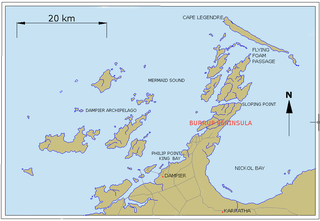
Dampier is a major industrial port in the Pilbara region in the northwest of Western Australia. It is located near the city of Karratha and Port Walcott.
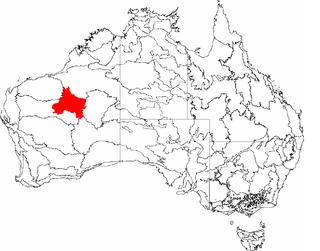
The Little Sandy Desert (LSD) is a desert region in the state of Western Australia, lying to the east of the Pilbara and north of the Gascoyne regions. It is part of the Western Desert cultural region, and was declared an interim Australian bioregion in the 1990s.
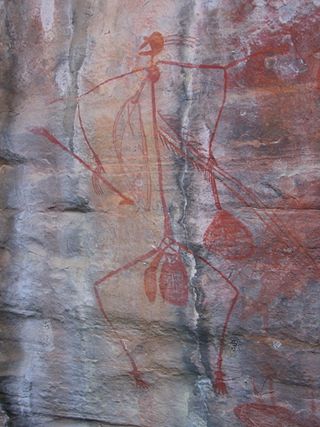
The prehistory of Australia is the period between the first human habitation of the Australian continent and the colonisation of Australia in 1788, which marks the start of consistent written documentation of Australia. This period has been variously estimated, with most evidence suggesting that it goes back between 50,000 and 65,000 years. This era is referred as prehistory rather than history because knowledge of this time period does not derive from written documentation. However, some argue that Indigenous oral tradition should be accorded an equal status.
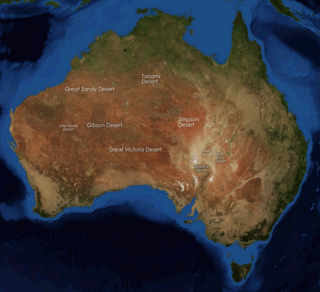
The deserts of Australia or the Australian deserts cover about 2,700,000 km2 (1,000,000 sq mi), or 18% of the Australian mainland, but about 35% of the Australian continent receives so little rain, it is practically desert. Collectively known as the Great Australian desert, they are primarily distributed throughout the Western Plateau and interior lowlands of the country, covering areas from South West Queensland, Far West region of New South Wales, Sunraysia in Victoria and Spencer Gulf in South Australia to the Barkly Tableland in Northern Territory and the Kimberley region in Western Australia.

Murujuga, formerly known as Dampier Island and today usually known as the Burrup Peninsula, is an area in the Dampier Archipelago, in the Pilbara region of Western Australia, containing the town of Dampier. The Dampier Rock Art Precinct, which covers the entire archipelago, is the subject of ongoing political debate due to historical and proposed industrial development. Over 40% of Murujuga lies within Murujuga National Park, which contains within it the world's largest collection of ancient 40,000 year old rock art (petroglyphs).
Peter Dixon Hiscock is an Australian archaeologist. Born in Melbourne, he obtained a PhD from the University of Queensland. Between 2013 and 2021, he was the inaugural Tom Austen Brown Professor of Australian Archaeology at the University of Sydney, having previously held a position in the School of Archaeology and Anthropology at the Australian National University.
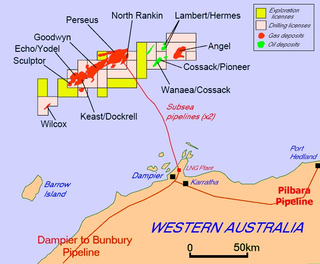
The North West Shelf Venture, situated in the north-west of Western Australia, is Australia's largest resource development project. It involves the extraction of petroleum at offshore production platforms, onshore processing and export of liquefied natural gas, and production of natural gas for industrial, commercial and domestic use within the state. North West Shelf gas is processed at the Woodside Energy operated Karratha Gas Plant, located on the Murujuga Cultural Landscape. The construction of the Karratha Gas Plant included one of the largest mass-destruction events of Aboriginal Cultural Heritage. The North West Shelf Venture is often cited as the single largest industrial emitter for Australia according to the Clean Energy Regulator.
Paul S.C. Taçon is an anthropologist and archaeologist based in Australia. He has conducted field work in Australia, Botswana, Cambodia, Canada, China, India, Malaysia, Myanmar, Thailand, South Africa and the United States. In 2011, he was appointed the first chair in Rock Art research at Griffith University on the Gold Coast, Australia. Taçon has made several key archaeological discoveries in Australia, most notably in western Arnhem Land (NT) and Wollemi National Park (NSW). These include the earliest rock art evidence of warfare in the world, the origins of the Rainbow Serpent, significant new Arnhem Land rock art sites, rock art discoveries in Wollemi National Park and the oldest rock paintings of Southeast Asian watercraft in Australia.
Josephine Mary Flood, is an English-born Australian archaeologist, mountaineer, and author.
Sandra Bowdler is an Australian archaeologist, emeritus professor of archaeology and former head of the Archaeology Department at the University of Western Australia.
Valerie Attenbrow is principal research scientist in the Anthropology Research Section of the Australian Museum, a position she has held since 1989.
The Yapurarra or Jaburara, also rendered Yaburara, are an Aboriginal Australian people whose traditional lands are in the Pilbara region of Western Australia and the Dampier Archipelago.
The Karieri people were an Indigenous Australian people of the Pilbara, who once lived around the coastal and inland area around and east of Port Hedland.

The Pilbara shrublands is a deserts and xeric shrublands ecoregion in Western Australia. It is coterminous with the Pilbara IBRA region. For other definitions and uses of "Pilbara region" see Pilbara.
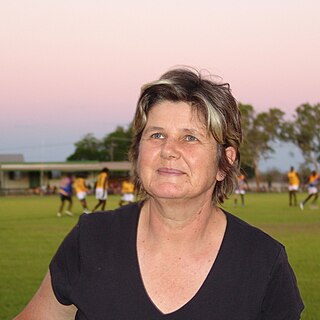
Jane Balme is a Professor of Archaeology at the University of Western Australia. She is an expert on early Indigenous groups and Australian archaeology.

Andrée Jeanne Rosenfeld FAHA (1934–2008) was an archaeologist specialising in rock art.
Caroline Bird is an Australian archaeologist and educator. She specialises in women's studies, cultural heritage, and indigenous studies in the archaeological context, specifically early Australian archaeology. Bird's other focuses include lithic technology and art.
Anne (Annie) Clarke is an Australian archaeologist and heritage specialist. She is a professor of archaeology and heritage at the University of Sydney. Clarke is a leading scholar in Australian archaeology, both historical and Aboriginal, as well as critical heritage studies. She has specialisms in archaeobotany, contact archaeology and rock art.
Lynley A. Wallis is an Australian archaeologist and Associate Professor at Griffith University. She is a specialist in palaeoenvironmental reconstruction through the analysis of phytoliths.
Sylvia Hallam, FAHA (1927–2019) was an English-born archaeologist who spent most of her academic career in Australia at the University of Western Australia. She is best known as author of Fire and Hearth and as an advocate for the protection of Aboriginal art, particularly at Murujuga in Western Australia.







